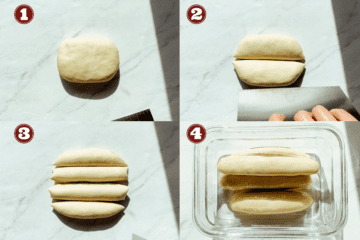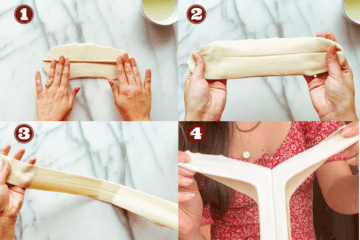Description
A thorough guide to hand-pulled noodles. Following these techniques, anyone can make deliciously chewy biang biang noodles at home, easily!
Ingredients
- 200g (about 1 1/2 cups) 00 pizza flour OR all-purpose flour (see notes)
- 100g (scant 1/2 cup) ice-cold water
- 1/2 teaspoon (3g) table salt
- 3 tablespoons or more neutral oil, for coating
Instructions
Prepare the Dough
- Mix the ice-cold water with salt until all ice is melted and the salt is dissolved.
- Add the flour into a large mixing bowl. Pour the salty water into the bowl bit by bit, and rub the flour between your thumb and fingers. Take your time; hydrating the flour without adding more water is the main goal here.
- Roughly knead the dough for a few minutes and shape it into a ball. It will look clumpy and that's okay. Cover with cling wrap and set aside for 30 minutes-1 hour. The light autolyse allows the flour to fully hydrate and makes pulling easier.
- After the autolyse, knead the dough until smooth, about 5-8 minutes. You can knead the same way as you would bread or any other dough. If using a stand mixer, knead on low power with the dough hook until the dough is very smooth.
Divide & Rest the Dough
- With a rolling pin, roll the dough out into a roughly 7-inch by 4-inch rectangle. Cut into four long dough strips, each will be about 7-inch by 1-inch. If making thin noodles (chenmian/latiaozi), see notes.
- Liberally oil a container or plate and toss the dough strips, making sure all surfaces are thoroughly covered with oil.
- Cover the container with plastic wrap, and ensure that the wrap clings to the surface of the dough strips to minimize air. Set aside on the counter for at least 4 hours. If you'd like to rest the dough strips overnight in the refrigerator (like pizza dough) for a deeper flavor—make sure to bring it back to room temperature before pulling.
Pull/Smack the Noodles
- Transfer one of the dough logs onto a large work surface. Pat dry to remove excess coating oil if necessary. Using a rolling pin, roll it out into a roughly 10-inch long, 3-inch wide sheet.
- Using a chopstick, make a shallow indentation right in the middle of your noodle. This will be where we rip it later.
- Now smack—or biang biang—the noodle by gently grabbing each side. Using as little force as possible, hold the dough in place using your thumbs, and smack the noodle down against the work surface about 10 times to lengthen it.
- Tear the noodle from the center through the indentation you made with the chopstick earlier. You can rip both ends, leave them intact, or rip only one end to get an extra-long noodle (this is what we usually do).
Boil & Serve
- Boil your noodles one at a time in salted water until they float, takes about 1-2 minutes. As the previous ones are boiling, you can prepare the next noodles.
- Transfer them to a serving bowl using a pair of tongs or chopsticks, and serve immediately. Please see the notes below for serving ideas.
- They don't keep well, but if necessary, you may save them in the refrigerator for up to 3 days. Coat them in a tiny bit of oil to avoid sticking.
Notes
Scale — Weighing your flour and water using a kitchen scale is highly recommended as volume measurements can often be inaccurate.
Flour — The ideal flour for hand-pulled noodles is freshly milled 00 pizza flour. It will yield the chewiest, most stretchable results. This higher-gluten flour gives noodles more bite, especially if fresh. But for these non-alkaline noodles, any all-purpose flour with over 10% gluten content will work provided you don't skip the autolyse. We tested this recipe with King Arthur's regular red wheat all-purpose flour (11.7% protein content) with consistently great results.
Hydration — With King Arthur's AP flour, 50% hydration yielded perfectly chewy, easy-to-pull noodles. Depending on which flour you are using, you may need to add a bit more water—up to 55%.
Thin Noodles (Chenmian) — After cutting the 7-inch by 4-inch rectangle into four long dough strips, further cut each 7x1 strip into six, lengthwise. This will give you 24 thin strips instead of 4 thick logs. You will also need to use more oil for coating. After the minimum-4-hour-long rest, roll out each noodle until doubled in length, then pull until the strip no longer feels stretchable. This pull should be consistent and smooth. At this point, you can smack the noodle down against your work surface a few times to lengthen it further. Check out this short video to see the technique. All other steps are identical to making the wide biang biang noodles.
Serving Suggestions — Hot Chili Oil & Garlic Biang Biang Noodles (Xi'an Famous Foods' Copycat); Dan Dan Noodles (made with thinner chenmian noodles); Garlic & Tofu Soup (better with thinner noodles).
- Prep Time: 30 minutes
- Rest Time: 4 hours 30 minutes
- Cook Time: 2 minutes
- Category: Mains, Pasta, Chinese
- Method: Boil
- Cuisine: Chinese


